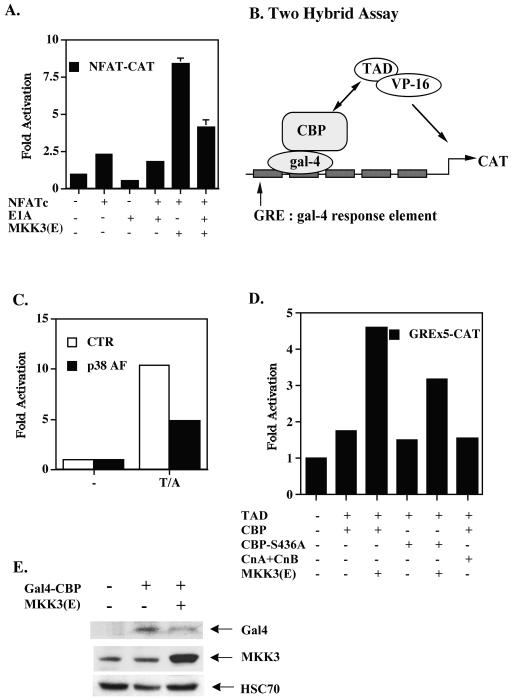FIG. 8.
p38 MAPK promotes the interaction between NFATc and CBP. (A) E1A inhibited p38 MAPK-stimulated NFAT activation. EL4 cells were transfected with NFAT-CAT in the presence of NFATc, E1A, or MKK3(E) as indicated. Cells were harvested 24 h after transfection, and CAT activities were determined. Data are reported as means and standard errors of the means. (B) Interaction of CBP and NFATc, as determined by the illustrated binding of pGAL-CBP to pVP16-NFAT(TAD) and the activation of pG5B-CAT (containing five tandem repeats of the GRE). (C) The NFAT-CBP interaction was p38 MAPK dependent. 293T cells were transfected with pGAL-CBP, pVP16-NFAT(TAD), or pG5B-CAT, with or without (CTR [control]) p38α(AF). After 24 h, 293T cells were stimulated with TPA and A23187 (T/A), and CAT activities were determined after another 24 h. −, no stimulation. (D) MKK3(E) stimulated NFATc-CBP binding. Jurkat T cells were transfected with pGAL-CBP or pGAL-CBP(S436A), pVP16-NFAT(TAD), pG5B-CAT, 1 μg of EGFP with or without calcineurin (both A and B subunits) (CnA+CnB), or MKK3(E) by the DEAE-dextran method. CAT activation was quantitated 24 h later. (E) Enhanced NFATc-CBP interaction was not due to MKK3(E)-stimulated Gal4-CBP expression. Levels of Gal4-CBP and MKK3(E) in panel D were quantitated with anti-Gal4 and anti-MKK3.

